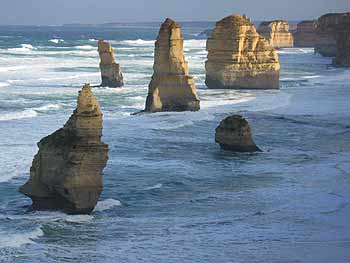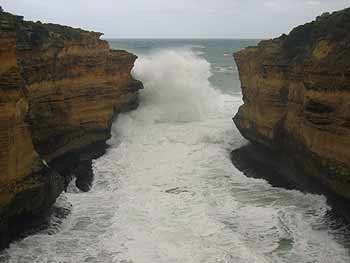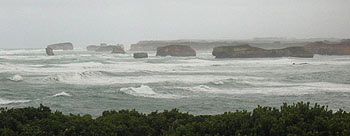The Southern Ocean Rocks
26th June, Great Ocean Road, Australia
Hoping that the cluster of clouds would part to let the sun shine through, we headed back to The Twelve Apostles, feeling uncertain but cautiously optimistic. It would be a shame not to see the spectacular coastal scenery in good conditions and it was, after all, only a 12km back-track. We pulled up into the car park and fully intended to wait a few hours for the perfect moment. The gods above were looking down on us today, though, and within five minutes the sun had pierced through a tiny gap in the clouds. That was our cue to hot-foot it out of the van and down to the lookout point.
Puffing and panting at the entrance to the lookout, we were relieved to see the Twelve Apostles still bathed in sunlight. The seven visible stacks stood prominently in the sea, covered in a golden glaze. I stood looking in awe at these rocks that are millions of years old. The ocean looked ferocious, thrashing at the foot of the apostles, driven by a strong south-westerly. The stacks are a fair distance from the mainland which highlights how powerful the forces of erosion can be.

As we left this area, the winds picked up some more and the weather pretty much went downhill after that. This didn't dampen our spirits though - with all this beautiful coastal scenery around us, we couldn't complain really. We spent most of the day continuing our journey down the Great Ocean Road and stopping off at various lookout points along the way.
The Blowhole and Thunder Cave
The Blowhole and Thunder Cave are in the same group of bays as the Loch Ard Gorge (which we'd covered yesterday). It was surprising to see the amount of activity going on in both these areas. The waves were extremely strong and the effects were magnified.
The Blowhole was like a highly-charged geyser and the Thunder Cave looked like a scaled down version of something out of the film: 'The Day After Tomorrow'. The Thunder Cave looked bursting with energy - at one point, a high wall of waves as tall as the height of the limestone cavity came piling in through the gap and rebounded on every single surface exposed to the water. Fortunately, the lookout point was set further back and we didn't get a drenching - although I did have my reservations!
A wall of water makes its way through the narrow cutting leading into Thunder
Cave.
The Arch
From the roadside, there was a sign indicating 'The Arch lookout' to our left. We took the diversion and saw the arch sitting in the sea in all its splendour. Again, the waves were attacking its base with force. The lookout platform is located in an exposed area and we, too, temporarily suffered the wrath of the wind.
London Bridge
Our next stop, London Bridge, used to be two adjoining coastal arches linked to the mainland. However, the first arch - the linker - collapsed dramatically in 1990. Fortunately, there were no fatalities, just two very shaken-up tourists who had crossed the link to the newly isolated arch only moments before. The stranded tourists were later rescued by helicopter! It is difficult to get an idea of perspective from a photo but these rocks are very tall. I shuddered to think how those tourists must have felt after watching the pathway collapse - how scary must that be?!
London Bridge, it's fallen down: to get a sense of scale, the people in
the foreground are a good 100 metres from the point where the arch used
to be. The two tourists who got stranded on the second arch would be no
bigger than a few pixels tall in this image.
Bay of Martyrs / Bay of Islands
The plan was not to stop off at any more lookouts until the Bay of Islands. Every time we got back in the van and warmed up a little, it was time to go back out again to check out another lookout. Seconds after making this decision, we stopped off at the Bay of Martyrs! From here, we could see the closely clustered stacks in the neighbouring Bay of Islands - it was too beautiful to miss. They are just as attractive as the Twelve Apostles, albeit slightly further away from the mainland. The thing about the Bay of Islands, though, is not so much the stacks that are left standing but the vast area that has obviously disappeared over the millions of years. It was almost incomprehensible, the sheer amount of rock that has disappeared into the sea over time.
The rough seas crashing into the many rocky stacks of the Bay of Islands.
Warrnambool
Whale-watching is a major attraction at Logan's Beach in Warrnambool especially between the months of May and October. This is when the southern right whales come to the warmer waters of South Australia to give birth and rear their young. It intrigues me why these whales come to the same spot every year - what is it about this place that they like?
The local newspaper was reporting on the front page that whales had been spotted over the last few days off Logan's Beach. So we, along with the many others who appeared to have read the article, piled onto the observation deck. Unfortunately, we didn't spot any as the seas were too rough. On a good day, the whales swim within 100m of the beach. The lady next to us spotted one far away in the horizon but she was using professional-looking binoculars. I looked down at my 'point-and-shoot' camera and gave up shortly afterwards.
Having covered a fair distance, we set up camp for the night further along the Princes Highway at a place called Port Fairy. It had been a busy day, stopping at one lookout after another. The highlight was definitely seeing the Twelve Apostles bathed in sunlight - a textbook example of 'third time lucky'!


